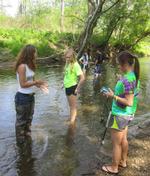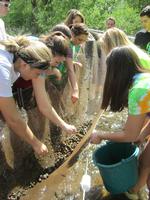Posted on Wednesday, May 22, 2013
Four years ago a tradition began that continued on May 17 when a dozen advanced placement (AP) biology students from Neshannock High School spent the day at the Westminster College Field Station studying the Little Neshannock Creek. The teacher of AP biology is Nancy Blank `89, who believes that the best laboratory for studying the chemistry and biology of water is outdoors.
The yellow bus, so familiar to school children, delivered the class to the Field Station, but from there the rest of the day was spent walking. A quick hike around the Field Station acquainted the students with projects that ranged from growing a historic forest to translating solar energy into electricity. Then the march to the creek with equipment for stream analysis began.
On site by the footbridge that crosses the Little Neshannock Creek, Dr. Stephanie Corrette-Bennett, a volunteer with the Science in Motion project, demonstrated equipment and how numbers for turbidity, nutrients and stream flow tell us the health of natural waterways. Of course, the only way to collect water samples is to get into the water of the creek. The pleasant air temperature and cloudless sky gave impetus to do just that. A student in the class, who was unable to get wet because of prior surgery on her foot, sat on the footbridge and served as recorder of the data yelled from the water.
Following the lab activity with the creek's chemical and physical characteristics, the students delved into the most appropriate activity for a biology class: finding living creatures of the stream. A kick net was stretched across the creek and students did the "Neshannock shuffle" to stir up the bottom and allow the net to catch forms of life. Crayfish, rainbow darters, stonefly and mayfly larvae and other macroinvertebrates were just some of the easily identified organisms. Habitats of muddy bottom and stony riffles showed differences.
The critters went into a bucket for transport back to the Nature Center for microscopic study. Bristles, scales, mouth parts, tubes made of glued-together grains of sand and more were viewed under microscopes. An occasional "wow" or screech (typical of high school students) punctuated the air as movements were observed up close. When the class was finished observing the living creatures, they were returned to their outdoor water. That's called conservation.
Students were required to name the streams of their watershed between Neshannock High School and the Atlantic Ocean; a task not that difficult.
A lunch on the premises and a brief time to walk the trail and the labyrinth concluded the outing before the yellow bus arrived a second time. Ms. Blank said, "see you again next year" and her students said, "thank you;" then departed on schedule to their afternoon sports and/or studies.
Clarence Harms, Director
Field Station

